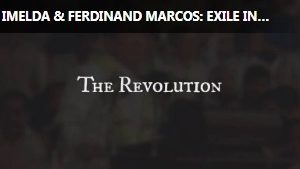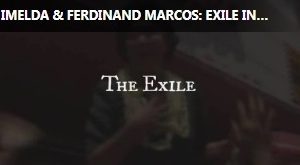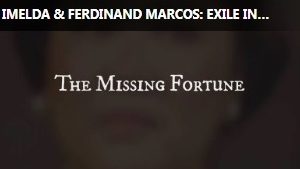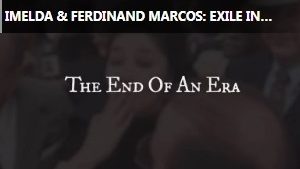Video Sources 0 Views
Imelda & Ferdinand: Exile In Hawaii: 1x3
Chapter III - The Exile
HONOLULU, Hawaii (HawaiiNewsNow) – Ferdinand Marcos’s authoritarian regime allowed him to do whatever he wanted; his embezzled fortunes allowed him to buy whatever he wanted.
But his 21-year reign came crashing down when Marcos fled the country under the cover of night on Feb. 25, 1986.
With a country on the brink of bloodshed and former supporters rioting against Marcos, the United States stepped in. President Ronald Reagan urged Marcos to leave and guaranteed him asylum if he came to the United States.
Marcos knew he had to take the offer.
On the night of their escape, the Marcos family and an entourage of about 90 people boarded U.S. Air Force planes to set course for Hickam Air Force Base in Honolulu.
When they landed the next morning, only news reporters and security personnel welcomed them at the airport. The environment was very different than the crowds of cheering supporters that had once greeted him during his previous visits.
“(Marcos) didn’t have very much clothing, and one of the daughters had indicated to me that that was the only clean clothes that they had,” said George Ariyoshi, the governor of Hawaii at the time, who was present to welcome the Marcos family.
But the exiled family, who said they left in haste, had time to grab other valuables before leaving the Philippines.
Reporters at the site of their arrival recorded the family getting off the plane with Pampers boxes in their arms. It was reported that 24 suitcases of gold bricks and diamond jewelry were hidden in these boxes.
Jim McCoy was a Hawaii reporter assigned to the Marcos beat. He said the Pampers boxes turned into something of an international incident.
“We heard that President Reagan was not happy about the Pampers and the jewelry in the Pampers boxes because it was kind of like they’re fleeing their home country, but they’re bringing all the loot with them,” McCoy said.
Opponents of Marcos rejoiced in their newfound freedom, setting off firecrackers and burning tires in the streets of Manila The crowd eventually took over the palace, once a symbol of the regime’s extravagance and corruption, and began destroying and looting all that was in the mansion.
“We are finally free, and we can be truly proud of the unprecedented way we achieved our freedom — with courage and with determination and most important, in peace,” said Corazon Aquino, the new president of the Philippines.
But while the Filipino people celebrated the end of a corrupt regime, Marcos never conceded losing control of the country he ruled for 20 years.
“This oppression came to the point that although I have control of superior military power and several opportunities to employ this military power, the employment of such an overwhelming force, no matter how legitimate, would have resulted in the bloody carnage among innocent civilians,” Marcos wrote in a letter to his people, detailing his version of his downfall.
The Marcos family couldn’t stay for long at Hickam Air Force Base, though.
They had been promised security and housing for up to a month but had to eventually move out into a rented four-bedroom beachfront house at 5577 Kalanianaole Highway.
While efforts to find the Marcos family a safe haven in another country were unsuccessful, they were still well taken care of. Friends paid for their stay, and security followed them there.
But not long after the family relocated, protesters arrived with signs in hand.
Honolulu attorney Eric Sythes said at the time: “Frankly, I’ve always been offended by the United States’ support for Marcos, but I’m even more offended by the fact that he’s here in Niu Valley or that he isn’t being sent back to the Philippines to face the legitimate feelings of the Filipino people, who I think would hang him if he were sent back.”
But not everyone in the United States opposed Marcos’ stay. Ferdinand and Imelda Marcos recognized this and began to make appearances around Honolulu to capitalize on this support.
Appearing in front of crowds chanting her name, Imelda Marcos would immerse herself among the people, letting them hug and kiss her. Supporters surged forward to touch her, to comfort her and to get a glimpse of the luxurious first lady.
Emme Tomimbang worked in Hawaii as a TV reporter and got exclusive access to the Marcos family.
“Well I think for her, it was a level of comfort, that she can amass this kind of reaction outside of her own country,” Tomimbang said. “So you know, all you’re doing is playing it on a smaller stage, but it’s the same routine, and she was always genuinely very open to her people.”
Although Imelda Marcos complained that living in exile was like a prison sentence, she still enjoyed the same lifestyle that she had in the Philippines.
She and her husband hosted extravagant dinners and weekly Sunday afternoon parties, catered by some of the most expensive restaurants in Honolulu. When she wasn’t entertaining her party guests, some of whom would fly in from different parts of the world just to attend, Imelda Marcos was shopping at designer dress shops in town.
Some of her frequent stops included upscale stores, such as Liberty House and Carol & Mary, where dresses cost as much as $900 each.
In September 1988, the couple celebrated Ferdinand Marcos’ 71st birthday with a six-hour party at the Blaisdell Center in downtown Honolulu.
The 2,000 guests who attended the event were among some of Hawaii’s top entertainers, and loyal supporters still referred to them as the president and the first lady.
Door prizes included lavish gifts, such as round-trip air fare to the Philippines and to Las Vegas.
The couple maintained this ostentatious lifestyle in exile, all while facing racketeering charges and time in prison.
“I do not intend to return to the Philippines unless I am needed there,” Ferdinand Marcos said.
“If my return will start a civil war, then the answer is no. I don’t intend to go there voluntarily offering my services and insisting that I be president.”
Copyright 2019 Hawaii News Now. All rights reserved.
 1 - 1Chapter I - The Good Life Dec. 18, 2024
1 - 1Chapter I - The Good Life Dec. 18, 2024 1 - 2Chapter II - The Revolution Dec. 18, 2024
1 - 2Chapter II - The Revolution Dec. 18, 2024 1 - 3Chapter III - The Exile Dec. 18, 2024
1 - 3Chapter III - The Exile Dec. 18, 2024 1 - 4Chapter IV - The Missing Fortune Dec. 18, 2024
1 - 4Chapter IV - The Missing Fortune Dec. 18, 2024 1 - 5Chapter V - The End of an Era - Finale Dec. 18, 2024
1 - 5Chapter V - The End of an Era - Finale Dec. 18, 2024





